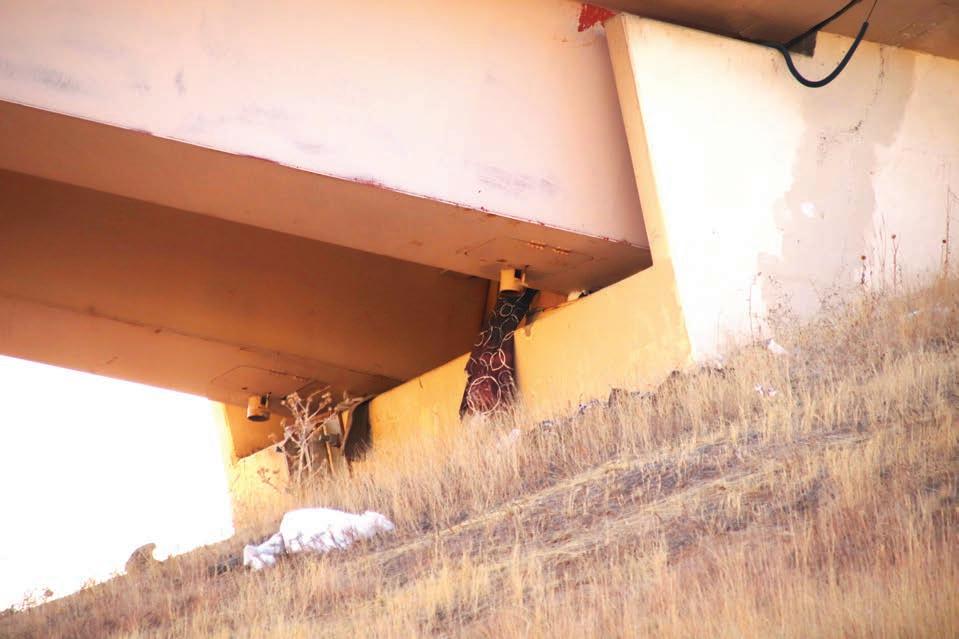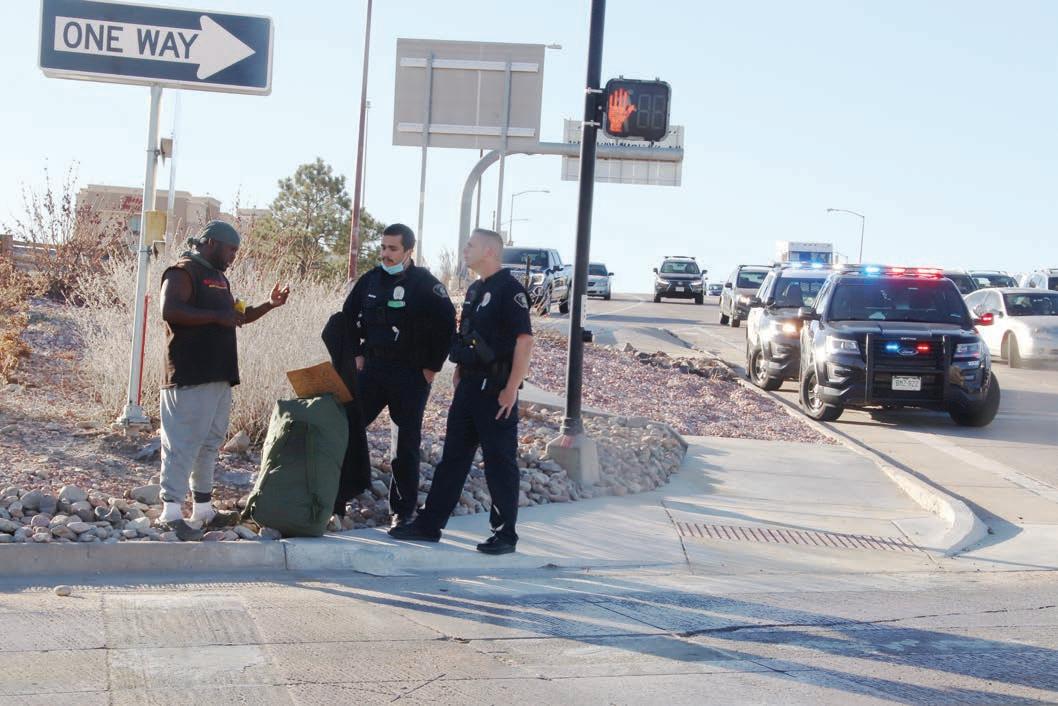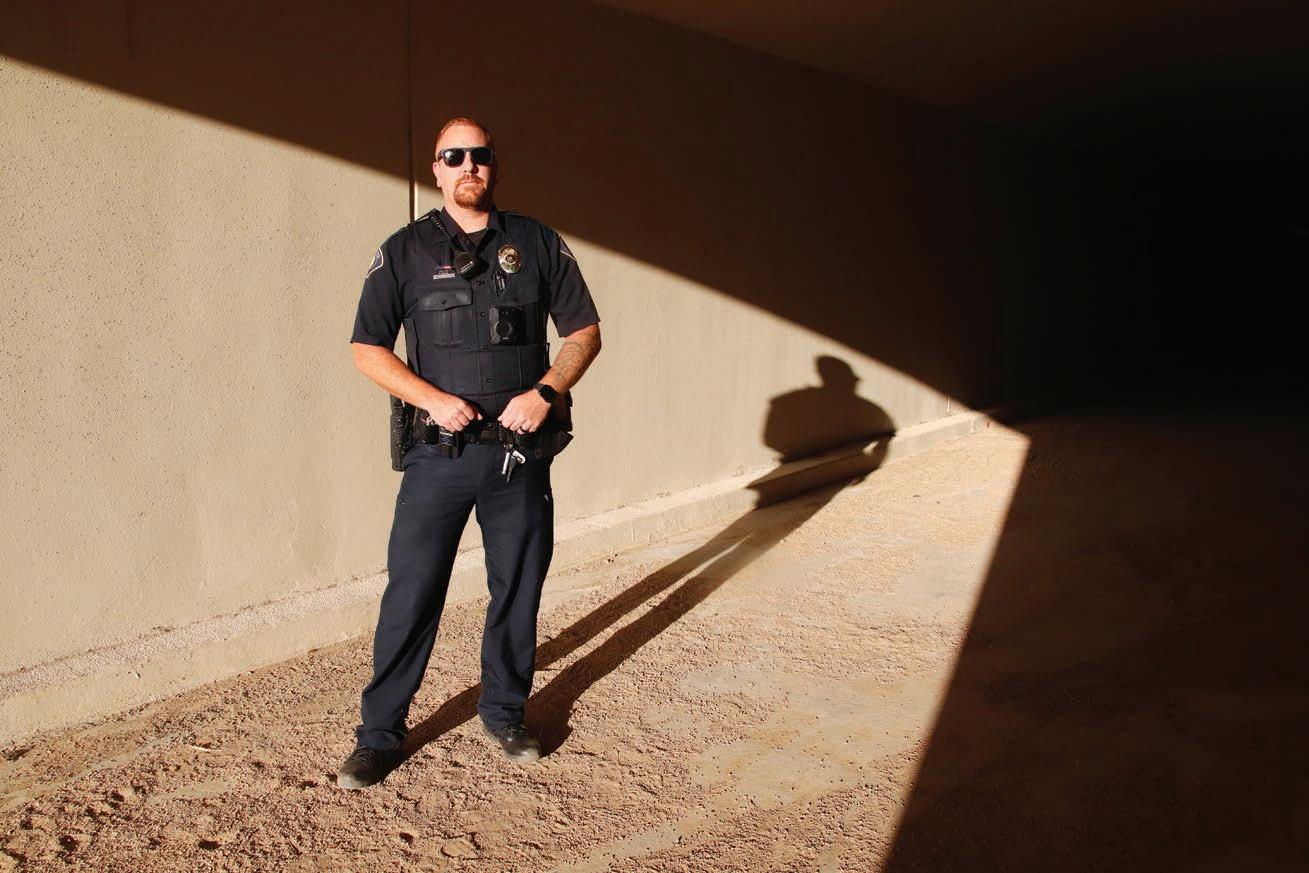
19 minute read
SEE HOMELESS
the reports have spanned the entire county, Makelky said.
This year, the county formed a Homeless Initiative to research how many unhoused people here and how they came to be in their situation — and to formulate a plan to address it.
Some in the county say the time is coming for additional local services to help people fi nd shelter or food. Others say that will only invite more transient populations. Still others are considering sweeping camping bans and other regulations for these groups.
In work sessions in October and December, Douglas County’s elected commissioners directed staff to begin considerations for a countywide camping-permit requirement and have said they’re not interested in creating homeless shelters for the community.
Camping bans already exist in Parker and Lone Tree and at least one councilmember in Castle Pines — Roger Hudson — has said he wants to see one implemented there. Castle Rock’s town council also voted Nov. 16 to begin discussions on addressing local homelessness.

Homelessness rising
So far, much of the evidence around the growing number of unhoused people in Douglas County is anecdotal. Data from the Metro Denver Homeless Initiative shows a mostly small, steady count of these populations in the county from their local “point in time” survey. But that doesn’t align with what county entities watching homelessness are seeing.
That’s why one of the fi rst things the county’s new Homeless Initiative wants to do is improve the way they count the community. The initiative also wants to better defi ne local homelessness and understand if it’s mostly people couch surfi ng, camping, sleeping in cars or something else.
Many of the anecdotal reports of increased homelessness have come from law enforcement, including the Douglas County Sheriff’s Offi ce and the Lone Tree police.
“I’ve been here 40 years, and we used to never have anything like this, and now we have it and it’s progressively getting more and more,” Spurlock said.
This is in a county with the highest median household income in metro Denver — $119,730 — and the lowest percentage of people in poverty — 2.7% — according to U.S. Census Bureau data for 2019.
The county, like most of metro Denver, has also seen sharp increases in housing costs in recent years. Median home sales values jumped 25% over the year ending in October, according to real-estate tracking company Zillow. And average rents in the county were up 5.2% in the fi rst three months of this year from late 2020, the largest quarterly rise since early 2019, according to county data.
Local offi cials say they are still working to understand the causes of any rise in homelessness in the county but have not yet pointed to high housing costs as a factor.
Kirk Wilson, Lone Tree’s chief of police, said his offi ce is defi nitely seeing more calls related to people experiencing homelessness lately.
County Commissioner Abe Laydon, who helps lead the county homeless initiative, fi rst noticed the increase when he saw multiple “really signifi cant encampments” in Lone Tree in 2020, he said.
“It seemed like the more I shared this with other people in Highlands Ranch and Parker, they had similar stories of more and more folks and people experiencing homelessness and panhandling,” he said.
The Douglas County School District’s total numbers of students experiencing homelessness has remained mostly steady and in some categories decreased. But the district has seen a continuous increase over the past decade in students in shelters, transitional housing or awaiting foster care, according to data from the Colorado Department of Education.
In the 2010 to 2011 school year, there were 37 DCSD students in this category. The school year that began in 2019 had 240.
It’s not just Douglas County, though. the region as a whole is seeing “more people experiencing homelessness than ever before,” said Cathy Alderman, chief communications and public policy offi cer for the Colorado Coalition for the Homeless.

A myriad of theories
Representatives from multiple county entities, including the county government and law enforcement agencies, have said they believe the people experiencing homelessness in the community have traveled from both Denver and Colorado Springs. None so far has said they’ve seen people who once had a home in the county but recently became unhoused, but all possible reasons are still being researched.
If so, why are more unhoused people migrating to Douglas County? Is it because, as some have suggested, they’re being pushed out of Denver and other areas by camping bans? Is it because of transportation challenges stemming from the jail and RTD?
Among Douglas County’s leaders, there are a myriad of theories fl oating around as to why this increase is happening but not yet any agreed-upon or verifi ed explanations.
In Lone Tree, law enforcement offi cials say they began to notice the uptick once several RTD light rail stations opened in 2019.
“Especially in the last two years there’s been a very big uptick in transients,” said Offi cer Ricky Stegmaier with the Lone Tree police. “We ask how they got here and a majority of the time it’s light rail.”
Stegamier said his offi ce uses the term “transient” to include more people than just those experiencing explicit homelessness.
Wilson, the Lone Tree police chief, also said he thinks the increase in the north Douglas County city is due to people riding the train down from Denver.
At the end of all light rail lines,



Lone Tree police o cers speak with a man who was seen panhandling in Lone Tree Dec. 2. Law enforcement was responding to
calls that the man appeared to be preparing to fi ght with another man panhandling there. PHOTOS BY ELLIOTT WENZLER
An abandoned urban camping site beneath a highway in Lone Tree.

Tony Spurlock,
Douglas County sheri



O cer Ricky Stegmaier poses for a portrait in a Lone Tree tunnel sometimes used as
shelter for those experiencing homelessness. PHOTO BY ELLIOTT WENZLER
HOMELESS
including the Ridgegate station in Lone Tree, riders are required to exit the train while it’s turned around. RTD does allow folks who accidentally went too far on the line to get back on and ride to their intended exit, said Steve Martingano, deputy chief of the agency’s transit police.
“Ridgegate has nothing there and I think that’s a little bit of the issue I think that we fi nd,” Martingano said. “There’s nothing at that end of the line.”
Martingano said that RTD doesn’t have a specifi c policy related to homelessness because as long as the person pays their fare, they are simply considered a customer. The agency is in the process of hiring a homeless outreach coordinator in an effort to address the growing issue, he said.
Another theory for why people without a steady home may travel to Douglas County is that it may represent a safer environment than densely populated areas like Denver, said both Makelky and Stegmaier.
County Commissioner George Teal suggested in one meeting on the topic that people who “choose to be homeless” come to Douglas County because the terrain and vegetation make it a “good place to hide.”
Laydon, another commissioner, said he believes it’s because those panhandling are more successful in the county. “People in Douglas County are generous and kind and I think there’s an awareness of that,” he said.
Makelky said sorting through all these ideas is an important part of what the new homeless initiative is hoping to do.
“Everything right now is theory and anecdotes,” he said. “And that’s what we’re trying to get past.”
What’s being done
While county agencies may not agree on why the increase is happening, they do seem to agree on one thing: Douglas County does not have many resources available to help people in this situation.
Some law enforcement agencies — such as Lone Tree — hand out pamphlets with lists of services to those experiencing homelessness, but virtually all the resources included are in Denver or other areas.
Stegmaier said that’s because Douglas County doesn’t have a consistently open homeless shelter and has limited options for food banks. While there is a shelter network of churches, it only operates in the winter and only allows women and children. He’s started to wonder if more services should be added, he said.
“What’s the community going to look like if that’s here? And I can see why we’d be hesitant on that, but do we need that? And I’m starting to think we do,” he said.
The county’s human resources department and other local nonprofi ts such as the Help and Hope Center, the Parker Task Force and SECOR Cares (SECOR stands for Southeast Community Outreach), also provide some services to vulnerable members of the community.
In an Oct. 5 work session, the county commissioners directed staff to begin looking into a camping permit system in the county, which would require anyone seeking to sleep outdoors to fi rst obtain a permit.
Teal and Laydon both indicated they would be interested in such a measure, but the third commissioner, Lora Thomas, said she was opposed.
“I would like to address homelessness as a choice in terms of our enforcement,” Teal said.
Teal also said he’s interested in a resolution that would provide assistance “for those experiencing homelessness by happenstance and it’s temporary.”
In the same meeting, Kelley Dunnaway, a deputy county attorney, said some in the community don’t want to see a local homeless shelter because it could invite more people in that situation to come to the county.
Laydon also said in an interview that he doesn’t want to “make the problem worse” by providing what he called “an endless well of support.” Instead, he said, the county should help individuals become self-suffi cient.
“We want to be compassionate but we don’t want to be victims of our own compassion where we’re allowing communities and businesses to suffer or go out of business or struggle and property values go down because of people experiencing homelessness,” he said.
‘A vagabond lifestyle’
In a Dec. 6 county commissioners work session, Terence Quinn, the director of community development for the county, asked the commissioners if they would consider pursuing new facilities and shelters for the homeless in addition to their other approaches.
“I would suggest we make the pie a little bit bigger and start talking about other avenues,” he said. “There may need to be some bigger discussions or bigger solutions down the road and potentially we can take a leadership role in that.”
The commissioners responded that they were not interested in that type of response, with Teal stating he would like to see faithbased rescue missions helping instead.
“I probably need to work on my compassion level,” Teal said, adding: “I have no interest in doing anything with county services that assists with a vagabond lifestyle, which I believe there is a prevalence of evidence that that’s what we’re seeing, it’s a vagabond lifestyle and I don’t think we should have any business facilitating that,” he said.
He added that he would like to help those who are “willing to work their way back” or are just traveling through the county to get to their destination.
“I’m hesitant to set up the refugee camps here in Douglas County under the idea that we can pay for it with our tax dollars,” Teal said. “I don’t have enough compassion in my model to see that as a viable use of public resources.”
The county will also likely soon amend their ordinance banning panhandling because similar laws have not held up to constitutional scrutiny, said county attorney Lance Ingalls. The county currently is not enforcing that oridinance, he said. Some courts across the country have found that outright bans on panhandling violate First Amendment rights to free speech.
Spurlock said he doesn’t view homelessness as a “law enforcement issue” and that he hopes the county will address it in a way that doesn’t involve passing more laws and ordinances to outlaw the behavior.
“We can’t just lock homeless people up in the jail. It’s not against the law to be homeless,” he said. “It’s not a good idea to use that as your remedy because that’s costly in the long term.”
Abe Laydon,
Douglas County commissioner
DOUGLAS COUNTY RESOURCES
For those interested in donating time or money, here are some Douglas County nonprofi ts helping those in the community who are struggling or experiencing homelessness: -Parker Task Force - 303-841-3460, www.ParkerTaskForce.org -Manna Connect - 720-515-8814 , www.MannaConnect.org -SECORCares - 720-842-5621, www. SecorCares.com -Help and Hope Center - 303-688-1114, www.HelpandHopeCenter.org -The ROCK Food Bank -303-688-0777, www.TheRock.org/foodbank -Winter Shelter Network - 720-2953116, www.WinterShelterNetwork.org -Catholic Charities - 720-215-4521, www.ccharitiescc.org/castle-rock-o ce
It’s goodbye, again, and I have a favor to ask
I’m not exactly sure what you’re supposed to do when you retire. I hear that often it involves hikes and beers with friends and reading the great books and binge-watching Marvel movies. Those all sound rewarding. But I’m not sure that’s going to hold me for long.
So for now at least, I’m staying away from using the word “retire” in referring to what’s happening to me this week. I’ll just call it a transition from one state of being to another.
After Dec.16, I am stepping down as editor of Colorado Community Media, the publisher of 24 weekly newspapers, of which this is one, across eight counties.
I’m a lucky guy to have been working full time for newspapers for almost all of the last 40 years. Every stop on my professional train ride has been fulfi lling and, for the most part, big fun. And I feel like I’ve played a small role in a great endeavor serving a vital public need: Providing honest news and information.
Actually, I fi rst exited this job last fall – I called it “semi-retiring” at the time — as I approached 65. I settled into freelance writing and reporting for various outlets along with contract editing for The Colorado Sun. Then, early this year, The Sun became co-owner of Colorado Community Media as a partner in the Colorado News Conservancy. Not long after that, Larry Ryckman, editor and co-founder of The Sun, asked if I would step back in for a few months while the hunt was underway for a new CCM publisher and permanent editor.
I’m grateful to Larry for the chance to work once again with our talented and enthusiastic crew of journalists. I’m also thankful that our new owners hired Linda Shapley, my former Denver Post colleague, as our publisher. She has worked tirelessly to bolster our business and to steer our company toward quality journalism and community service.
And come January, my role as CCM editor will be fi lled by Lisa Schlichtman, a veteran Colorado editor and a resourceful newsroom leader. I wish her great success.
The talented Thelma Grimes, who has been helping us cover Douglas County communities, has already assumed my other role, as the regional editor overseeing our weekly newspapers in Arapahoe, Denver, Douglas and Elbert counties, with help from copy editor Scott Gilbert. Thelma joins our regional editing team of Kristen Fiore (Jefferson and Clear Creek counties), Scott Taylor (Adams and Weld counties) and Christy Steadman (Denver neighborhood monthlies). Thanks to all of them for their efforts.
As you know, it’s been a tumultuous year amid the pandemic, with debates over masks, schools grappling with COVID-19 and race education, packed hospitals, contentious elections and businesses struggling to thrive again. Our reporters have shown dedication, creativity and courage in keeping you informed, in many cases covering stories that no one else is covering.
As I step away, I have a favor to ask. It’s expensive to bring you the news you need. So I’m hoping you will help CCM continue as an honest, independent, locally-focused information source with a contribution.
Consider it an investment in democracy.
Through an initiative called #newsCOneeds, in collaboration with the Colorado Media Project, if you contribute to CCM from now until Dec. 31, your money will be doubled, up to $1,000, for a total of $5,000 in matching funds.
For information on how to support us, go online to coloradocommunitymedia.com/readers-care, or call 303-566-4100.
If you’re a business, you can help underwrite our community journalism by advertising. Visit ccmengage. com for information. If you’re a reader, please patronize businesses that advertise in this newspaper and thank them for their support.
CCM is headed to a bright future under Linda and Lisa’s leadership and with ownership committed to the best in community news. I will be watching closely from the sidelines and cheering on CCM’s successes. And I will be unfolding my hometown Centennial Citizen each week and clicking on ColoradoCommunityMedia.com to keep current.
It’s been a pleasure helping to bring you news. Thank you for reading, now and always. I wish you joyful holidays and a happy, healthy and prosperous new year.
FROM THE EDITOR
Mark Harden
After Dec. 16, reach Mark at mhardenpro@gmail.com. On Twitter: @MarkHardenNews
BAAMING our way into 2022
There was no one else in the hotel gym that morning. The music playing in her earbuds was upbeat, fast-paced and loud. Almost loud enough to drown out her heavy breathing as she neared the end of a high-intensity workout.
There was no one else around, she was spent, and she could have easily ended her workout in that moment without anyone else knowing it. But she would know it, and that’s all that mattered.
Not only did she complete her last few sets, but she also added another minute of cardio and one extra set of push-ups, BAAM.
The workday was coming to an end. It had been a brutal day of calling prospects and customers. He was coming up on the end of his sales year and he needed at least three more sales to reach his annual quota. His colleagues were getting ready to pack it in for the day. Laptops were closing, headsets being laid on desks, and plans being made to meet up for a drink after work.
Instead of shutting down, he resolved to make at least 10 more calls before he left. Those 10 calls went fast as no one answered. As he was about to stand up and go join his teammates, he dialed one more number. The person answered. The call took 45 minutes, and he made the sale, BAAM. Christmas was coming up quickly. Ever since they were married, they were a dual-income household, raising three children.
This past year had been rough as they both had to fi nd new employment opportunities. Although it wasn’t ideal, they were also both working second jobs to cover their bills, including a tuition payment that was due, and provide a decent Christmas for the family.
They were tired, exhausted really, and although they knew they just needed to stick it out for another few weeks, for their own personal health and well-being they were going to quit their part-time jobs.
Over coffee the next morning they rallied and encouraged one another to make it through one more week. They did, and then one more week, and then the fi nal week too, BAAM.
So, what is this whole BAAM thing anyway? BAAM stands for “Block and a Mailbox.”
When the great motivational speaker Zig Ziglar set a goal to get into better shape, he needed to start running. The fi rst day he ran only a block. The second day, he ran a block and a mailbox. The third day he ran a block and two mailboxes.
Each day he just went a little further than he did the day before. Each day he gave just a little more, worked a little harder, and didn’t give in. That became one of the hallmarks of his life, BAAM.
Known as one of the greatest motivational speakers and encouragers in the last century, not only did Ziglar follow his own BAAM guidance in everything that he did, but he also taught all of us who studied his works and heard him speak how to do the same thing. Do a little more, reach a little higher, go further than you think you can, live more, love harder, laugh often, and learn as much as we possibly can.
To this day, when I feel like I have had enough or reached my limit, I ask myself if I can get to the next “mailbox” in front of me, and I BAAM it.
It has been a tiring past 21 months. There is so much going on and on many different fronts. Until now, it could have been easy to fall into the trap of giving up and giving in. But now we know better, and you may love me or hate me for this, because now all we have to do is look at what is just a little further ahead of us and go for it.
I would love to hear your BAAM story at mnorton@tramazing. com, and when we do just a little bit more to reach our goals and dreams, it really will be a better than good year.
WINNING WORDS
Michael Norton
Michael Norton is the grateful CEO of Tramazing.com, a personal and professional coach, and a consultant, trainer, encourager and motivator to businesses of all sizes.
A publication of
LINDA SHAPLEY
Publisher
lshapley@coloradocommunitymedia.com
MARK HARDEN
Interim Editor
mharden@coloradocommunitymedia.com
JESSICA GIBBS
Community Editor
ERIN ADDENBROOKE
Marketing Consultant
eaddenbrooke@coloradocommunitymedia.com
AUDREY BROOKS
Business Manager
abrooks@coloradocommunitymedia.com
ERIN FRANKS
Production Manager
Columnists & Guest Commentaries
Columnist opinions are not necessarily those of the Voice. We welcome letters to the editor. Please include your full name, address and the best number to reach you by telephone.
Email letters to
letters@coloradocommunitymedia.com
Deadline
Wed. for the following week’s paper. To opt in or out of delivery please email us at circulation@ coloradocommunitymedia.com
Lone Tree Voice
A legal newspaper of general circulation in Lone Tree, Colorado, the Voice is published weekly on Thursday by Colorado Community Media, 9233 Park Meadows Dr., Lone Tree, CO 80124. Send address change to: Lone Tree Voice, 750 W. Hampden Ave., Suite 225, Englewood, CO 80110

